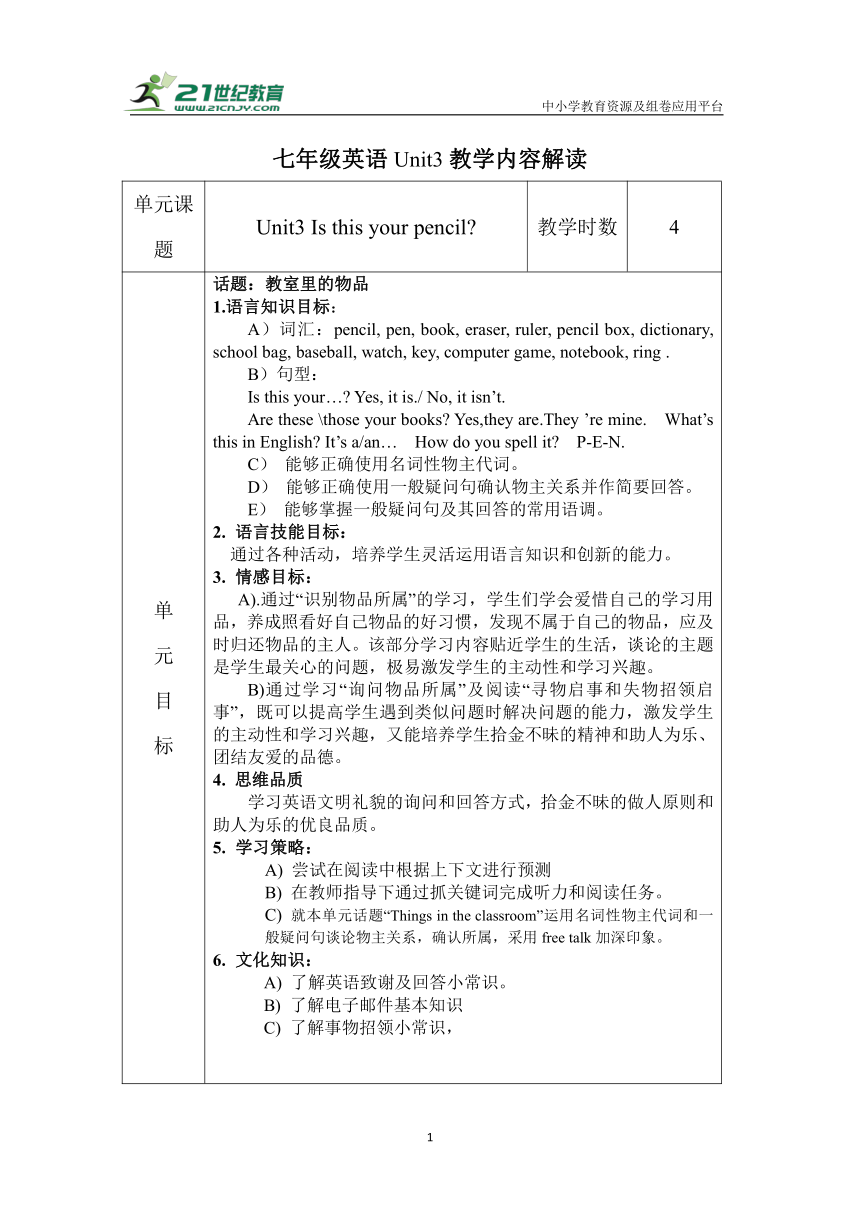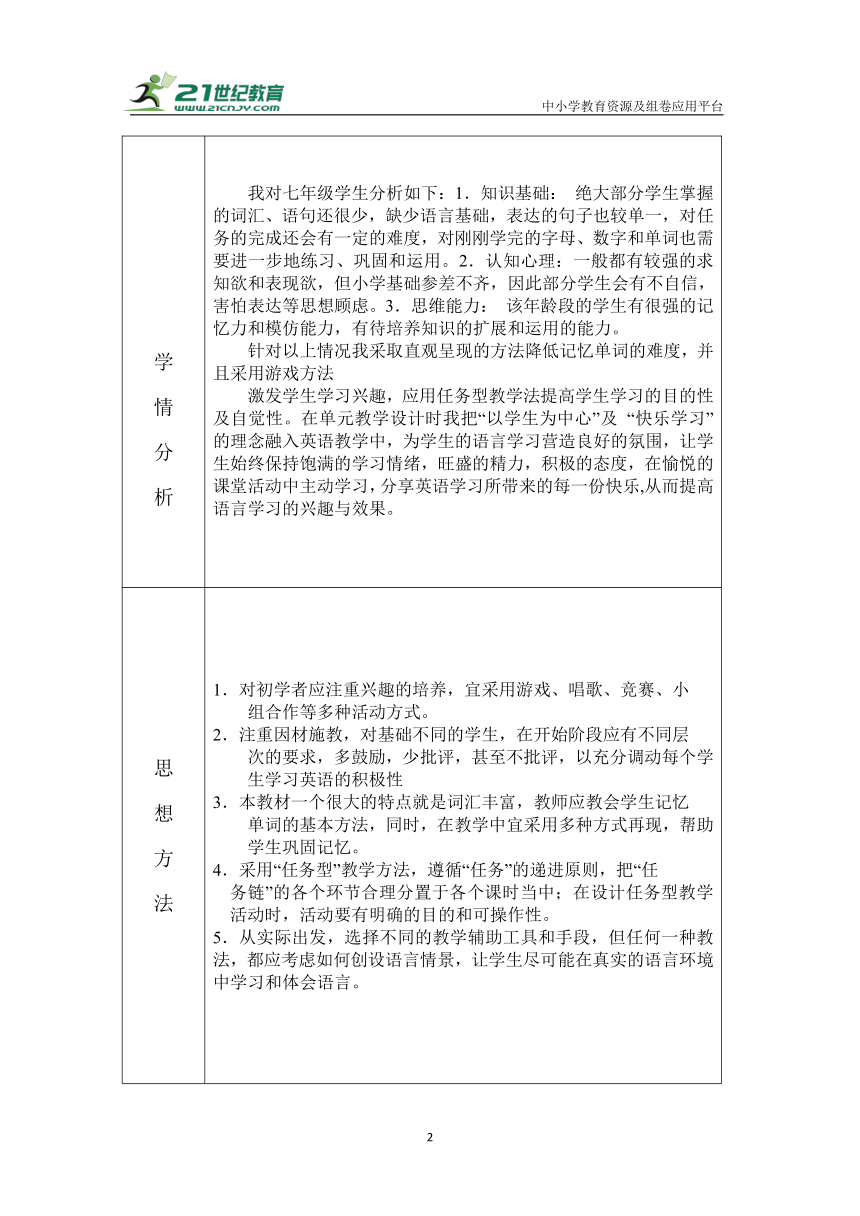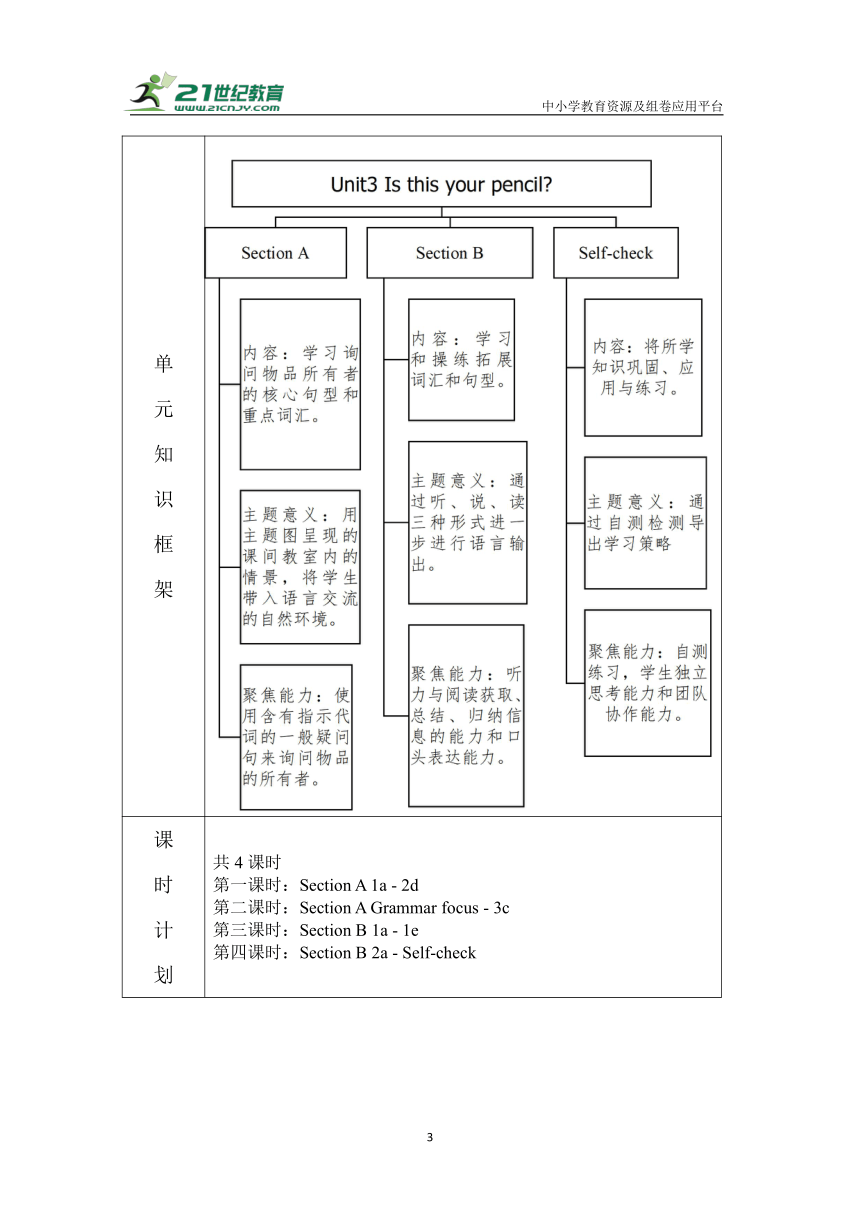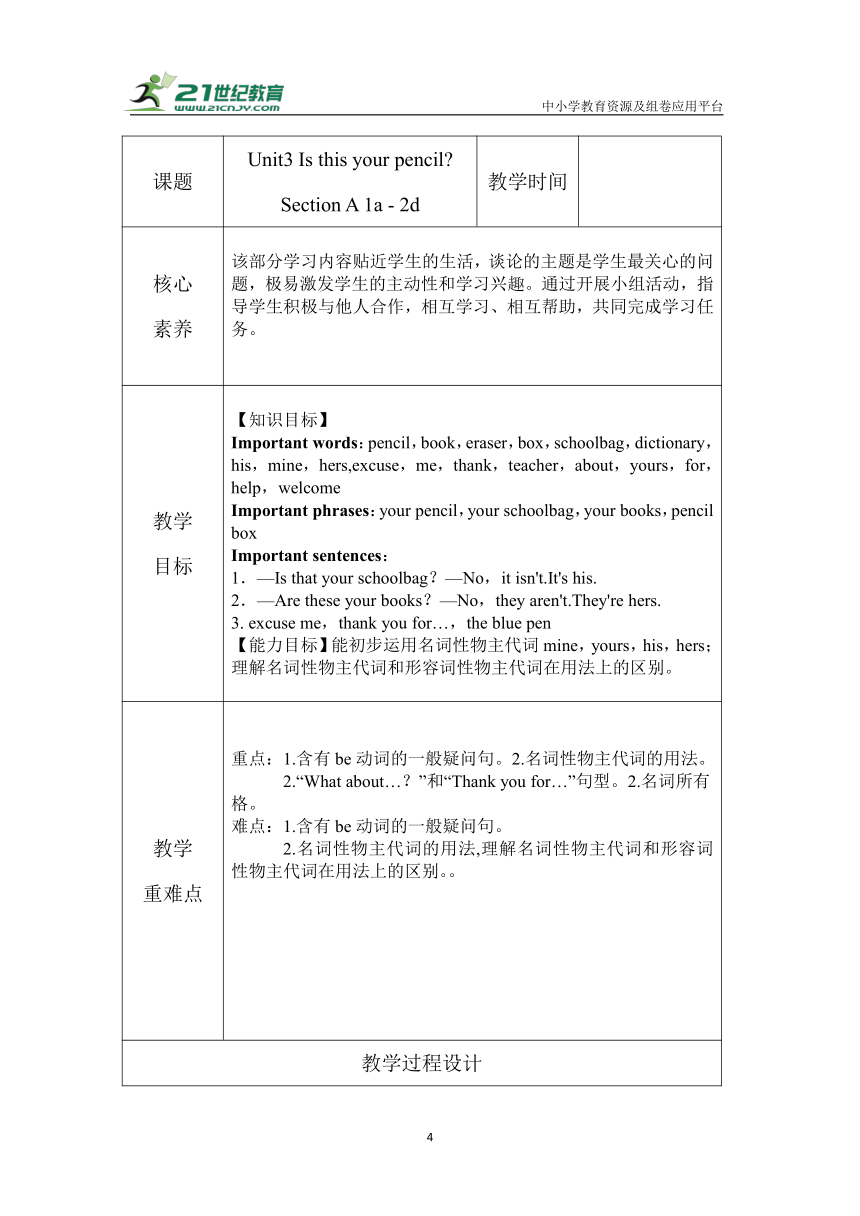核心素养目标Unit 3 Is this your pencil? section A 单元整体教学设计
文档属性
| 名称 | 核心素养目标Unit 3 Is this your pencil? section A 单元整体教学设计 |

|
|
| 格式 | docx | ||
| 文件大小 | 364.5KB | ||
| 资源类型 | 试卷 | ||
| 版本资源 | 人教新目标(Go for it)版 | ||
| 科目 | 英语 | ||
| 更新时间 | 2023-10-24 15:21:44 | ||
图片预览





文档简介
七年级英语Unit3教学内容解读
单元课题 Unit3 Is this your pencil 教学时数 4
单 元 目 标 话题:教室里的物品 1.语言知识目标: A)词汇:pencil, pen, book, eraser, ruler, pencil box, dictionary, school bag, baseball, watch, key, computer game, notebook, ring . B)句型: Is this your… Yes, it is./ No, it isn’t. Are these \those your books Yes,they are.They ’re mine. What’s this in English It’s a/an… How do you spell it P-E-N. 能够正确使用名词性物主代词。 能够正确使用一般疑问句确认物主关系并作简要回答。 能够掌握一般疑问句及其回答的常用语调。 语言技能目标: 通过各种活动,培养学生灵活运用语言知识和创新的能力。 情感目标: A).通过“识别物品所属”的学习,学生们学会爱惜自己的学习用品,养成照看好自己物品的好习惯,发现不属于自己的物品,应及时归还物品的主人。该部分学习内容贴近学生的生活,谈论的主题是学生最关心的问题,极易激发学生的主动性和学习兴趣。 B)通过学习“询问物品所属”及阅读“寻物启事和失物招领启事”,既可以提高学生遇到类似问题时解决问题的能力,激发学生的主动性和学习兴趣,又能培养学生拾金不昧的精神和助人为乐、团结友爱的品德。 4. 思维品质 学习英语文明礼貌的询问和回答方式,拾金不昧的做人原则和助人为乐的优良品质。 学习策略: 尝试在阅读中根据上下文进行预测 在教师指导下通过抓关键词完成听力和阅读任务。 就本单元话题“Things in the classroom”运用名词性物主代词和一般疑问句谈论物主关系,确认所属,采用free talk加深印象。 文化知识: 了解英语致谢及回答小常识。 了解电子邮件基本知识 了解事物招领小常识,
学 情 分 析 我对七年级学生分析如下:1.知识基础: 绝大部分学生掌握的词汇、语句还很少,缺少语言基础,表达的句子也较单一,对任务的完成还会有一定的难度,对刚刚学完的字母、数字和单词也需要进一步地练习、巩固和运用。2.认知心理:一般都有较强的求知欲和表现欲,但小学基础参差不齐,因此部分学生会有不自信,害怕表达等思想顾虑。3.思维能力: 该年龄段的学生有很强的记忆力和模仿能力,有待培养知识的扩展和运用的能力。 针对以上情况我采取直观呈现的方法降低记忆单词的难度,并且采用游戏方法 激发学生学习兴趣,应用任务型教学法提高学生学习的目的性及自觉性。在单元教学设计时我把“以学生为中心”及 “快乐学习”的理念融入英语教学中,为学生的语言学习营造良好的氛围,让学生始终保持饱满的学习情绪,旺盛的精力,积极的态度,在愉悦的课堂活动中主动学习,分享英语学习所带来的每一份快乐,从而提高语言学习的兴趣与效果。
思 想 方 法 对初学者应注重兴趣的培养,宜采用游戏、唱歌、竞赛、小 组合作等多种活动方式。 注重因材施教,对基础不同的学生,在开始阶段应有不同层 次的要求,多鼓励,少批评,甚至不批评,以充分调动每个学生学习英语的积极性 本教材一个很大的特点就是词汇丰富,教师应教会学生记忆 单词的基本方法,同时,在教学中宜采用多种方式再现,帮助学生巩固记忆。 采用“任务型”教学方法,遵循“任务”的递进原则,把“任 务链”的各个环节合理分置于各个课时当中;在设计任务型教学活动时,活动要有明确的目的和可操作性。 从实际出发,选择不同的教学辅助工具和手段,但任何一种教法,都应考虑如何创设语言情景,让学生尽可能在真实的语言环境中学习和体会语言。
单 元 知 识 框 架
课 时 计 划 共4课时 第一课时:Section A 1a - 2d 第二课时:Section A Grammar focus - 3c 第三课时:Section B 1a - 1e 第四课时:Section B 2a - Self-check
中小学教育资源及组卷应用平台
课题 Unit3 Is this your pencil Section A 1a - 2d 教学时间
核心 素养 该部分学习内容贴近学生的生活,谈论的主题是学生最关心的问题,极易激发学生的主动性和学习兴趣。通过开展小组活动,指导学生积极与他人合作,相互学习、相互帮助,共同完成学习任务。
教学 目标 【知识目标】 Important words:pencil,book,eraser,box,schoolbag,dictionary,his,mine,hers,excuse,me,thank,teacher,about,yours,for,help,welcome Important phrases:your pencil,your schoolbag,your books,pencil box Important sentences: 1.—Is that your schoolbag?—No,it isn't.It's his. 2.—Are these your books?—No,they aren't.They're hers. 3. excuse me,thank you for…,the blue pen 【能力目标】能初步运用名词性物主代词mine,yours,his,hers;理解名词性物主代词和形容词性物主代词在用法上的区别。
教学 重难点 重点:1.含有be动词的一般疑问句。2.名词性物主代词的用法。 2.“What about…?”和“Thank you for…”句型。2.名词所有格。 难点:1.含有be动词的一般疑问句。 2.名词性物主代词的用法,理解名词性物主代词和形容词性物主代词在用法上的区别。。
教学过程设计
Step 1.lead in 以一个“Is this your pencil”视频导入课题,用图片的形式让学生认识新单词 Step 2.Presentation 1. Pretend that you don’t know whose these things are and ask A: “Is this your book ” And lead him/her to answer: “Yes, it is. It’s mine.” Then take another one and ask its owner: “Is this your schoolbag ” Help him/her to answer: “No, it isn’t. It’s his.” Have the students ask and answer in pairs. (Maybe when they do this, they’ll make mistakes, so the teacher come to them and give them help if necessary.) Then ask them to act their dialogues out. — Is this your book — Yes, it is. It’s mine. — Is this your schoolbag — No, it isn’t. It’s his/hers. 2. Tell Ss: my book = mine; his book = his; her book = hers Step 3.Listening T: Now please listen to the three conversations, the first time you only listen. Then I play again. And this time you listen and number the conversations. (Point to the boxes to show where students write the numbers for the conversations. Teacher plays the tape and students listen to it and finish 1b.) T: Let’s check the answers, OK Ss: … (from left to right) T: Thank you. Step 4.Pair work 1. Get the students to work in pairs to practice these conversations. 2. Ask them to practice in groups. Walk around the classroom to check pronunciation and intonation. Then call some groups to perform their conversations in front of the class. Step 4.Listening 1. Work on 2a. T: Please look at the pictures in 2a. Can you say their English names (Teacher asks the students to name each one individually.) S1: This is … S2: This is … S3: … T: Now please take out the objects in 2a and put them on the desk. You will listen to a dialogue and please pick up the things you hear. Let’s see who will do fastest and best. (Play the recording for the students to listen.) (让学生把听到的物品选出来,放在自己的桌子上,让学生动手去做,比单纯的单词辨听更易引起学生学习的兴趣。) T: Now let’s check the answers. Please hold the things you hear and say their English names, OK (Make sure students hold the things to show them to the other students.) 2. Work on 2b. T: Now please read the words. One holds the things, the others read them aloud one by one. (One student holds the things, and the other students say the words aloud.) T: This time you will listen to the recording again, and you will write one of the words from the box on each blank line. (Play the recording. Students listen and complete the conversation.) T: Let’s check the answers. I’d like to ask three students to read the conversation in role. (Three students read the conversation, filling the missing words. The rest of the students check their answers.) Step 5.group work 1. T: Now please practice the conversation with your partner. 2. Ask some pairs to act out the dialogue in front of the class. 3. T: Now collect some more school things from your classmates. Then make a new conversation with your partner. Then practice your conversation. 4. Ask some pairs stand up and act out their dialogue using the school things they collected. Step 6.Role-play 1. Read the conversation and underline the school things in the dialogue. (Ss read the dialogue and underline the school things. Check their answers with their partner.) 2. Now look at the screen. Read the conversation again and match the things with its owner. (Ss read the conversation and match the things with its owner. Check their answers with their partner.) 3. Let Ss read the dialogue after the teacher. Then let Ss practice the conversation. 4. Ask some pairs to act out the conversation in front of the class. 5. 评价:(让学生们对自己的表现及语言表达能力进行自我评价,在小组内评价,然后进行评出最优秀的小组。并鼓励学生们下一次争取做最优秀的小组及个人。) Step 7.Homework: 1. Let Ss collect their school things and try to say them in English. 2. Collect some things from your classmates. And make a conversation with your partner.
教学反思
课题 Unit3 Is this your pencil Section A Grammar focus-3c 教学时间
核心 素养 通过“识别物品所属”的学习,学生们学会爱惜自己的学习用品,养成照看好自己物品的好习惯,发现不属于自己的物品,应及时归还物品的主人。
教学 目标 【知识目标】 Important sentences: 1.—Is this his green pen?—Yes it is./No,it isn't.The blue pen is his. 2.—Are those her keys?—Yes,they are./No,they aren't.They're mine. 【能力目标】根据不同场景,能用英语对物品所属进行提问和回答。 【情感目标】通过“识别物品所属”的学习,学生们学会爱惜自己的学习用品,养成照看好自己物品的好习惯,发现不属于自己的物品,应及时归还物品的主人。
教学 重难点 重点: 1.总结归纳辨认物品所有者所用的句型。 2.通过进行不同形式的对话练习来熟练运用辨认物品所有者的句型,同时复习所学的学习用品的词汇。 难点: 总结归纳辨认物品所有者所用的句型并熟练运用这些句型。
教学过程设计
Step 1. Warming-up 目的:本活动为了复习已学过的物品单词和目标语言,为下一个阅读活动作准备。 方案1:收集一些物品,问全班学生: What’s this How do you spell it 全班学生集体作答。 方案2: ·收集两个学生(a boy and a girl)的物品,与单个学生进行回答:What’s this Is this his / her… How do you spell it 把收集到的物品放远一些,再进行对话练习,引出目标语言Is that…?顺势导入新课:让学生在2a练习题中写出自己经常丢失的物品名称,巩固所学新单词。 Step 2. Read (2b、2c) 目的:本活动是为了让学生看懂简单的失物招领和寻物启事。 建议: 这是一个简单的阅读活动,教师可以在学生阅读之前先练习目标语言。 方案1: 师生对话练习句型 Is that…? T: Is this your eraser, David S: Yes, it is. / No ,it isn’t, it’s his eraser. T: And is that your pencil 帮助学生理解单词和短语: call Allan at 495-3539, computer game, lost and found box, ID card。 学生完成2b、2c中的任务。 方案2: 师生对话练习句型 Is that… Call me at…. 学生完成2b、2c的任务并诵读其内容。 Step plete the notices (3a) 目的:本活动是上一个阅读活动的延伸,是为了培养学生对Lost or Found notice的练习和书写能力。 操作: ·让学生弄清题意,并阅读方框中的内容。 ·学生完成3a任务。 ·请一个学生汇报他的答案,并读出完整信息。·让另一个学生把完整信息写在黑板上。 ·学生轮流向全班诵读3a活动中的寻物启事和失物招领启事。 Step 4. Write(3b) 目的:本活动是为了培养学生的阅读能力和教会学生写简单的失物招领和寻物启示。 操作:让学生每人模仿写一份实物招领和寻物启事,看谁写得图文并茂。把写得好的贴在教室里全班展示。如果有时间请几位学生在班上诵读,否则把它当作家庭作业。 Step 5. Summarize the whole class. Step 6.Homework
教学反思
单元课题 Unit3 Is this your pencil 教学时数 4
单 元 目 标 话题:教室里的物品 1.语言知识目标: A)词汇:pencil, pen, book, eraser, ruler, pencil box, dictionary, school bag, baseball, watch, key, computer game, notebook, ring . B)句型: Is this your… Yes, it is./ No, it isn’t. Are these \those your books Yes,they are.They ’re mine. What’s this in English It’s a/an… How do you spell it P-E-N. 能够正确使用名词性物主代词。 能够正确使用一般疑问句确认物主关系并作简要回答。 能够掌握一般疑问句及其回答的常用语调。 语言技能目标: 通过各种活动,培养学生灵活运用语言知识和创新的能力。 情感目标: A).通过“识别物品所属”的学习,学生们学会爱惜自己的学习用品,养成照看好自己物品的好习惯,发现不属于自己的物品,应及时归还物品的主人。该部分学习内容贴近学生的生活,谈论的主题是学生最关心的问题,极易激发学生的主动性和学习兴趣。 B)通过学习“询问物品所属”及阅读“寻物启事和失物招领启事”,既可以提高学生遇到类似问题时解决问题的能力,激发学生的主动性和学习兴趣,又能培养学生拾金不昧的精神和助人为乐、团结友爱的品德。 4. 思维品质 学习英语文明礼貌的询问和回答方式,拾金不昧的做人原则和助人为乐的优良品质。 学习策略: 尝试在阅读中根据上下文进行预测 在教师指导下通过抓关键词完成听力和阅读任务。 就本单元话题“Things in the classroom”运用名词性物主代词和一般疑问句谈论物主关系,确认所属,采用free talk加深印象。 文化知识: 了解英语致谢及回答小常识。 了解电子邮件基本知识 了解事物招领小常识,
学 情 分 析 我对七年级学生分析如下:1.知识基础: 绝大部分学生掌握的词汇、语句还很少,缺少语言基础,表达的句子也较单一,对任务的完成还会有一定的难度,对刚刚学完的字母、数字和单词也需要进一步地练习、巩固和运用。2.认知心理:一般都有较强的求知欲和表现欲,但小学基础参差不齐,因此部分学生会有不自信,害怕表达等思想顾虑。3.思维能力: 该年龄段的学生有很强的记忆力和模仿能力,有待培养知识的扩展和运用的能力。 针对以上情况我采取直观呈现的方法降低记忆单词的难度,并且采用游戏方法 激发学生学习兴趣,应用任务型教学法提高学生学习的目的性及自觉性。在单元教学设计时我把“以学生为中心”及 “快乐学习”的理念融入英语教学中,为学生的语言学习营造良好的氛围,让学生始终保持饱满的学习情绪,旺盛的精力,积极的态度,在愉悦的课堂活动中主动学习,分享英语学习所带来的每一份快乐,从而提高语言学习的兴趣与效果。
思 想 方 法 对初学者应注重兴趣的培养,宜采用游戏、唱歌、竞赛、小 组合作等多种活动方式。 注重因材施教,对基础不同的学生,在开始阶段应有不同层 次的要求,多鼓励,少批评,甚至不批评,以充分调动每个学生学习英语的积极性 本教材一个很大的特点就是词汇丰富,教师应教会学生记忆 单词的基本方法,同时,在教学中宜采用多种方式再现,帮助学生巩固记忆。 采用“任务型”教学方法,遵循“任务”的递进原则,把“任 务链”的各个环节合理分置于各个课时当中;在设计任务型教学活动时,活动要有明确的目的和可操作性。 从实际出发,选择不同的教学辅助工具和手段,但任何一种教法,都应考虑如何创设语言情景,让学生尽可能在真实的语言环境中学习和体会语言。
单 元 知 识 框 架
课 时 计 划 共4课时 第一课时:Section A 1a - 2d 第二课时:Section A Grammar focus - 3c 第三课时:Section B 1a - 1e 第四课时:Section B 2a - Self-check
中小学教育资源及组卷应用平台
课题 Unit3 Is this your pencil Section A 1a - 2d 教学时间
核心 素养 该部分学习内容贴近学生的生活,谈论的主题是学生最关心的问题,极易激发学生的主动性和学习兴趣。通过开展小组活动,指导学生积极与他人合作,相互学习、相互帮助,共同完成学习任务。
教学 目标 【知识目标】 Important words:pencil,book,eraser,box,schoolbag,dictionary,his,mine,hers,excuse,me,thank,teacher,about,yours,for,help,welcome Important phrases:your pencil,your schoolbag,your books,pencil box Important sentences: 1.—Is that your schoolbag?—No,it isn't.It's his. 2.—Are these your books?—No,they aren't.They're hers. 3. excuse me,thank you for…,the blue pen 【能力目标】能初步运用名词性物主代词mine,yours,his,hers;理解名词性物主代词和形容词性物主代词在用法上的区别。
教学 重难点 重点:1.含有be动词的一般疑问句。2.名词性物主代词的用法。 2.“What about…?”和“Thank you for…”句型。2.名词所有格。 难点:1.含有be动词的一般疑问句。 2.名词性物主代词的用法,理解名词性物主代词和形容词性物主代词在用法上的区别。。
教学过程设计
Step 1.lead in 以一个“Is this your pencil”视频导入课题,用图片的形式让学生认识新单词 Step 2.Presentation 1. Pretend that you don’t know whose these things are and ask A: “Is this your book ” And lead him/her to answer: “Yes, it is. It’s mine.” Then take another one and ask its owner: “Is this your schoolbag ” Help him/her to answer: “No, it isn’t. It’s his.” Have the students ask and answer in pairs. (Maybe when they do this, they’ll make mistakes, so the teacher come to them and give them help if necessary.) Then ask them to act their dialogues out. — Is this your book — Yes, it is. It’s mine. — Is this your schoolbag — No, it isn’t. It’s his/hers. 2. Tell Ss: my book = mine; his book = his; her book = hers Step 3.Listening T: Now please listen to the three conversations, the first time you only listen. Then I play again. And this time you listen and number the conversations. (Point to the boxes to show where students write the numbers for the conversations. Teacher plays the tape and students listen to it and finish 1b.) T: Let’s check the answers, OK Ss: … (from left to right) T: Thank you. Step 4.Pair work 1. Get the students to work in pairs to practice these conversations. 2. Ask them to practice in groups. Walk around the classroom to check pronunciation and intonation. Then call some groups to perform their conversations in front of the class. Step 4.Listening 1. Work on 2a. T: Please look at the pictures in 2a. Can you say their English names (Teacher asks the students to name each one individually.) S1: This is … S2: This is … S3: … T: Now please take out the objects in 2a and put them on the desk. You will listen to a dialogue and please pick up the things you hear. Let’s see who will do fastest and best. (Play the recording for the students to listen.) (让学生把听到的物品选出来,放在自己的桌子上,让学生动手去做,比单纯的单词辨听更易引起学生学习的兴趣。) T: Now let’s check the answers. Please hold the things you hear and say their English names, OK (Make sure students hold the things to show them to the other students.) 2. Work on 2b. T: Now please read the words. One holds the things, the others read them aloud one by one. (One student holds the things, and the other students say the words aloud.) T: This time you will listen to the recording again, and you will write one of the words from the box on each blank line. (Play the recording. Students listen and complete the conversation.) T: Let’s check the answers. I’d like to ask three students to read the conversation in role. (Three students read the conversation, filling the missing words. The rest of the students check their answers.) Step 5.group work 1. T: Now please practice the conversation with your partner. 2. Ask some pairs to act out the dialogue in front of the class. 3. T: Now collect some more school things from your classmates. Then make a new conversation with your partner. Then practice your conversation. 4. Ask some pairs stand up and act out their dialogue using the school things they collected. Step 6.Role-play 1. Read the conversation and underline the school things in the dialogue. (Ss read the dialogue and underline the school things. Check their answers with their partner.) 2. Now look at the screen. Read the conversation again and match the things with its owner. (Ss read the conversation and match the things with its owner. Check their answers with their partner.) 3. Let Ss read the dialogue after the teacher. Then let Ss practice the conversation. 4. Ask some pairs to act out the conversation in front of the class. 5. 评价:(让学生们对自己的表现及语言表达能力进行自我评价,在小组内评价,然后进行评出最优秀的小组。并鼓励学生们下一次争取做最优秀的小组及个人。) Step 7.Homework: 1. Let Ss collect their school things and try to say them in English. 2. Collect some things from your classmates. And make a conversation with your partner.
教学反思
课题 Unit3 Is this your pencil Section A Grammar focus-3c 教学时间
核心 素养 通过“识别物品所属”的学习,学生们学会爱惜自己的学习用品,养成照看好自己物品的好习惯,发现不属于自己的物品,应及时归还物品的主人。
教学 目标 【知识目标】 Important sentences: 1.—Is this his green pen?—Yes it is./No,it isn't.The blue pen is his. 2.—Are those her keys?—Yes,they are./No,they aren't.They're mine. 【能力目标】根据不同场景,能用英语对物品所属进行提问和回答。 【情感目标】通过“识别物品所属”的学习,学生们学会爱惜自己的学习用品,养成照看好自己物品的好习惯,发现不属于自己的物品,应及时归还物品的主人。
教学 重难点 重点: 1.总结归纳辨认物品所有者所用的句型。 2.通过进行不同形式的对话练习来熟练运用辨认物品所有者的句型,同时复习所学的学习用品的词汇。 难点: 总结归纳辨认物品所有者所用的句型并熟练运用这些句型。
教学过程设计
Step 1. Warming-up 目的:本活动为了复习已学过的物品单词和目标语言,为下一个阅读活动作准备。 方案1:收集一些物品,问全班学生: What’s this How do you spell it 全班学生集体作答。 方案2: ·收集两个学生(a boy and a girl)的物品,与单个学生进行回答:What’s this Is this his / her… How do you spell it 把收集到的物品放远一些,再进行对话练习,引出目标语言Is that…?顺势导入新课:让学生在2a练习题中写出自己经常丢失的物品名称,巩固所学新单词。 Step 2. Read (2b、2c) 目的:本活动是为了让学生看懂简单的失物招领和寻物启事。 建议: 这是一个简单的阅读活动,教师可以在学生阅读之前先练习目标语言。 方案1: 师生对话练习句型 Is that…? T: Is this your eraser, David S: Yes, it is. / No ,it isn’t, it’s his eraser. T: And is that your pencil 帮助学生理解单词和短语: call Allan at 495-3539, computer game, lost and found box, ID card。 学生完成2b、2c中的任务。 方案2: 师生对话练习句型 Is that… Call me at…. 学生完成2b、2c的任务并诵读其内容。 Step plete the notices (3a) 目的:本活动是上一个阅读活动的延伸,是为了培养学生对Lost or Found notice的练习和书写能力。 操作: ·让学生弄清题意,并阅读方框中的内容。 ·学生完成3a任务。 ·请一个学生汇报他的答案,并读出完整信息。·让另一个学生把完整信息写在黑板上。 ·学生轮流向全班诵读3a活动中的寻物启事和失物招领启事。 Step 4. Write(3b) 目的:本活动是为了培养学生的阅读能力和教会学生写简单的失物招领和寻物启示。 操作:让学生每人模仿写一份实物招领和寻物启事,看谁写得图文并茂。把写得好的贴在教室里全班展示。如果有时间请几位学生在班上诵读,否则把它当作家庭作业。 Step 5. Summarize the whole class. Step 6.Homework
教学反思
同课章节目录
- starters 预备篇(2012秋审查)
- Unit 1 Good morning !
- Unit 2 What’s this in English?
- Unit 3 What color is it ?
- Unit 1 My name's Gina.
- Section A
- Section B
- Unit 2 This is my sister.
- Section A
- Section B
- Unit 3 Is this your pencil?
- Section A
- Section B
- Unit 4 Where's my schoolbag?
- Section A
- Section B
- Unit 5 Do you have a soccer ball?
- Section A
- Section B
- Unit 6 Do you like bananas?
- Section A
- Section B
- Unit 7 How much are these socks?
- Section A
- Section B
- Unit 8 When is your birthday?
- Section A
- Section B
- Unit 9 My favorite subject is science.
- Section A
- Section B
